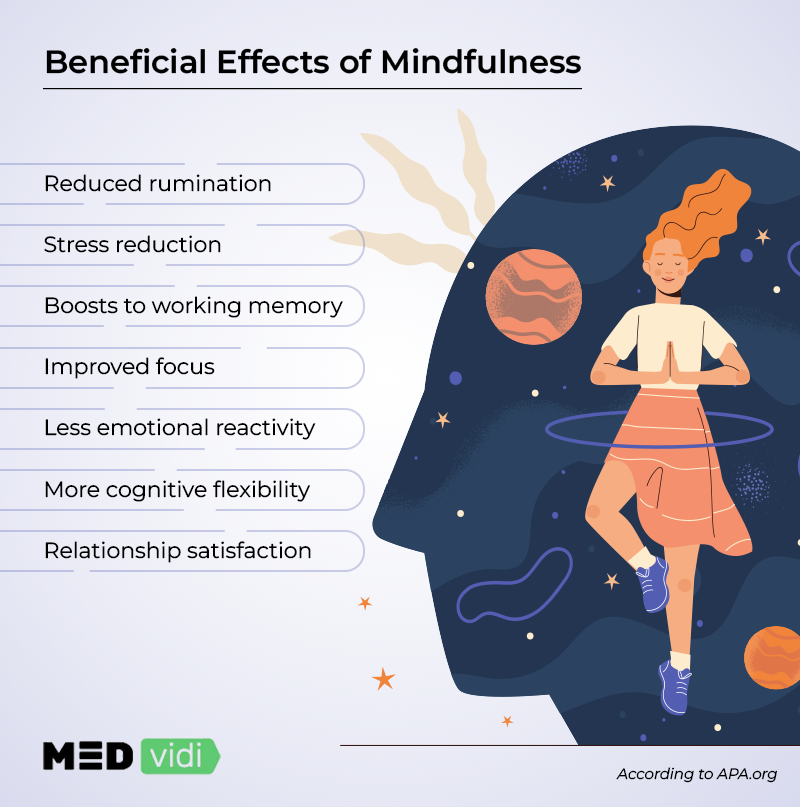Every individual strives to be happier, experience more balance and peace, and focus on the essential things in life. Practicing mindfulness can help achieve this.
But what is mindfulness?
In brief, it is the practice of concentrating on the present without judgment. Such an attitude grows awareness and helps one make better decisions without biases.
The best part is, mindfulness does not require you to be seated in a crossed-legged position like a monk for a long time. Anyone can practice mindfulness techniques for concentration beyond the meditation space. You can refer to them wherever and whenever you wish, so it is a good solution for those with busy lifestyles. Let’s learn more about mindfulness and how to practice it!
Do you feel stressed? MEDvidi doctors are ready to help by offering personalized mental health support.
Simple Mindfulness Techniques for Every Day
Mindfulness can be a beneficial supplement to treating anxiety, stress, insomnia, or depression. It is also a good solution for those who just lack joy.
The hack is to find a unique simple practice that fits with the reality of daily life. And here are five techniques you may like:
Observing the Thoughts Without Judgment
Judgmental tendencies and mind wandering are very common. The first step to mastering mind concentration techniques is acceptance and patience with these thoughts. Be compassionate. Be kind.
Mindfulness meditation aims to accept all thoughts and give them full attention. This helps observe the happenings in the present moment. Treat every stray thought with compassion and understanding as you bring it back to focus.
This is how it works:
- Sit in a chair or bed in an upright position with eyes closed and the spine straight. Observe the sensations in the body.
- Take three long deep breaths, let it settle into its pace, and notice the movement of your chest and stomach when breathing.
- After settling in, the next step is to observe the thoughts. Keep bringing the stray thoughts back into focus.
- If you practice in the morning, set the intention for the day. What is there to achieve for the day, and which is the best way for individuals to take better care of themselves?
Throughout the day, keep checking on the intentions and physical senses when you find it difficult to concentrate or feel overwhelmed.
Being mindful about your thinking and behavioral patterns is among the benefits cognitive-behavioral therapy can bring.
“Waking Up” and Noticing Your Present
It’s estimated that people’s brains run on 95% autopilot. The core of all human behavior and habits is neural networks or the subconscious brain that create shortcuts for efficient functioning in a chaotic world.
The neurons force a person to fall back into the tried and tested old habits by default. On the other hand, mindfulness puts brakes on default processes to create new pathways. There will often be a tussle between the desire to create new habits and following the familiar ones, often resulting in autopilot. But since the basis for every behavior is consistent repetition, mindfulness can become a constant habit too.
There are several ways to perform mindful training for your brain, which is responsible for creating new patterns. Anyone can do this through the following mindfulness activities:
- In the morning, think of your to-do list.
- Make physical reminders for important tasks and ensure they are set somewhere that’s hard to miss.
- Be present when doing your tasks, not thinking of other ones.

Being Mindful When Walking
Walking brings numerous opportunities for such practices. People can refer to them even as they move to and from their car or the store, take short walks to the gym or around the neighborhood, or enjoy hiking.
A mindful walk is slow, calculated, and conscious. It’s about paying attention to sounds, smells, the ground, sensations on the skin, and awareness of everything around us, such as the beauty of nature. Feel the steps, the vibrations they create, and how they feel.
A more productive, mindful walk is when individuals have no particular place they are going. They are just taking a walk without making a point of getting anywhere.
Want to know more about mindfulness and mental evaluation online that help to improve mental well-being? Contact us today!
Being Mindful When Working Out
Sweating it out in the gym or jogging can be valuable mindful practice. Instead of just looking to lose weight or sculpt the body, gymers can pay more attention to breathing and movement in a way that changes the focus from the muscle and distractions to being capable, strong, and calm.
For mindfulness practices in the workouts, try these tips:
- Have a clear goal or intention. Play the workout in mind and envision what’s to be achieved. For example, individuals can resolve to breathe more deeply or notice the little things like the singing of birds outdoors.
- Before the main exercises, it’s essential to warm up and try matching the breaths with movement. Rhythmic movements help align brain activity, breathing, and focus, stabilizing the nervous system. The workouts become more mentally and physically effective.
- It’s also essential for people to practice mindfulness exercises to keep moving the goalposts farther. They should add a few feet or miles to their runs or a few pounds into their weightlifting. This provides more opportunities for mindfulness under stress.
Ensuring Single-tasking
In a society with fast-paced lives, doing multiple things simultaneously has become the trend. People want to do as much as possible within the shortest time.
While multitasking may seem the most logical way to achieve productivity, it is not. Instead, it robs people of the communicative and creative processes. Stopping one task midway to start another breaks the flow and the momentum needed to do a great job.
Multitasking is also not good for your health. The desire to accomplish many things at the same time often produces feelings of being overwhelmed and burnt out. On the contrary, single-tasking allows creative processes to flow, increases tranquility, and brings more task enjoyment.
Awareness of the task at hand calls for discipline. It is resisting the urge to do something else while the current task remains unfinished. Be conscious of the desire to switch tasks and bring the mind back into focus (this is important to initiate mindful moments).
Some of the things that individuals can do to help with single-tasking based on mindfulness exercises include:
- Switching off the phone when working
- Using a timer on a particular task. This shifts the focus to one thing at a time for a definite period.
When individuals do one thing at a time, they become more focused and efficient and gain peace of mind when they accomplish it. People gain more inspiration and see new ways to achieve the same goal more efficiently. This is what productivity is all about.
Conclusion
When done right and frequently, mindfulness techniques can help improve the quality of life, and people can become the best versions of themselves. It’s about what individuals pay attention to. The trick is to bring the focus into the present while doing so with gentleness and compassion. In some cases, practicing mindfulness can be a good addition to psychotherapy, specifically for depression and anxiety treatment. Contact us today to know how to overcome your symptoms using an integrative approach.












